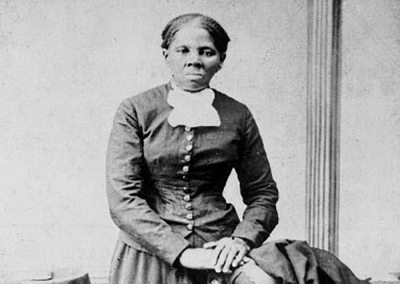The currency of Harriet Tubman

Harriet Tubman has yet to appear on the twenty-dollar bill or any federal note. But the hero of the Underground Railroad has newly minted cultural currency of her own. The biopic Harriet, directed by Kasi Lemmons and starring Cynthia Erivo, delivers suspense and vindication. And there’s a new biography: She Came to Slay: the Life and Times of Harriet Tubman, by Erica Armstrong Dunbar. There must be something about Harriet Tubman that America needs right now: a testimony that the North Star still shines through the fog of partisanship and prejudice.
Born in 1822 into slavery in Delaware, Harriet was a small child when two of her sisters were sold. She heard their cries and felt her parent’s tears. She spent her childhood as a hireling, performing disagreeable chores for neighbors. She trapped muskrats, hoed weeds and scrubbed floors while the coins she earned jingled in her owner’s pocket.
When Harriet was still a child, an accident changed her life. An angry white man, hurled a two pound weight at a black boy. The intended target dodged and the object hit Harriet’s forehead, fracturing her skull. For the rest of her life she had “spells” that brought disturbing visions--horsemen chasing runaways, children crying for their parents. Harriet believed that God sent the visions to warn her of danger.
After she reached adulthood Harriet heard that she was going to be sold. She vowed to live free or die. Though she had never been far from home, she must now travel some hundred miles through forest and field, and swamp. Running by night and hiding by day, she eluded slavecatchers and found safety in Philadelphia. But with her family still enslaved, she could not rest.
Soon she was heading South in disguise, to rescue others. Over ten years she made thirteen trips and freed at least seventy people—earning the title “the Moses of her people.” But to slaveholders, she was a criminal with a price on her head.
On one trip, a man in her group panicked and begged to turn back. “You can die right here,” she said, aiming her pistol at him. “Or go on with us.” Tubman knew that this man, once in the clutches of his master, would be whipped until he told all: the routes Tubman used, the secret hiding places and the friends who gave food and shelter. Years later Tubman said, “I was the conductor of the Underground Railroad for eight years, and I never ran my train off the track and I never lost a passenger.”
During the Civil War, Tubman was hired as a spy by the Union Army, but spent most of her time nursing soldiers and baking pies. Finally she got an assignment that made good use of her talents. She guided black soldiers along the Combahee River in South Carolina, in a raid that burned many plantations and set 750 people free.
After the war Tubman was heading home. She boarded a train, showed her military pass and took a seat in a passenger car. The conductor told her to move to the “smoking car” where blacks had to ride. She refused. Two more conductors came and, three against one, they forced Tubman from her seat and threw her into the smoking car, breaking her arm and bruising her ribs.
She recovered at her home in Auburn New York, her courage and generosity unbroken. Though poor herself, she sheltered and fed family, friends and strangers. She was an active worshipper at the African Episcopal Church, Zion, where she loved to pray and sing. “Swing Low, Sweet Chariot,” was her favorite spiritual, a promise of deliverance.
Tubman lived on faith and hard work. She had to, since the pension owed her by the U.S. Army was not forthcoming. She had married a veteran of the U.S. Colored Troops and after he died, her widow’s pension of $8.00 per month was held up for years. Finally she got the widow’s pension and her own for her wartime service as a nurse. But, according to Dunbar, she never was compensated for her work as a spy or scout.
In her old age, Tubman spoke out at women’s rights meetings and believed women should vote. Her compassion inspired her last brave deed. With the support of her church, the “Tubman Home for Aged and Indigent Negroes” opened in 1908. When her own health failed, she received care at the Home she had founded. She was 91 years old when pneumonia took her in 1913. With her last words, she quoted Jesus. “I go to prepare a place for you, that where I am you may be also.” Whether or not Harriet Tubman is memorialized on a Federal Reserve Note, her life is freedom’s currency and it needs to stay in circulation.
Nancy Koester is the author of Harriet Beecher Stowe: a Spiritual Life and an affiliated scholar at the Faith and Liberty Discovery Center in Philadelphia, Pennsylvania. Currently she is working on biography of Sojourner Truth.



























